
|
To quickly and easily access any blackline master needed for MathLinks 8, just click and print.
To extract the files from the zip folder, a software compression utility is required. A free evaluation version of Winzip is avalaible here.
|
|
If you have a combined grade 7 and 8 class, you may find the information in this link useful. Click here to download a suggestion for organizing your lessons using a staggered approach. Both classes start by doing data (Chapter 12 of MathLinks 7 and Chapter 1 of MathLinks 8).
To view this file, Adobe's free Acrobat Reader application is required.
|
| If you have a combined grade 8 and 9 class, you may find the information in this link useful. Click here to download a suggestion for organizing your lessons using a staggered approach. The chapters in this section build the basic skills for each of the grade levels. |
|
To view these files, Adobe's free Acrobat Reader application is required.
|
|
Use these interactive, and engaging lessons to enhance your students classroom experience.
WhiteBoard Lessons PowerPoint Lessons * To extract the files from the zip folder, a software compression utility is required. A free evaluation version of Winzip is available here.
|
| Chapter 1 Section 1.1, History Link, Page 10 |
||
| http://www.hhof.com/LegendsOfHockey/html/silver_splashstanleycup.htm | ||
| This Hockey Hall of Fame website provides a history and statistics on the Stanley Cup as well as a biography of Lord Stanley of Preston. ( http://www.hhof.com/LegendsOfHockey/html/silver_splashstanleycup.htm ) |
||
| Chapter 2 Chapter 2, Math Link, Page 45 |
||
| http://www.folklorama.ca/ | ||
| This is an attractive, informative website about the Winnipeg Folklorama festival. ( http://www.folklorama.ca/ ) |
||
| Section 2.2, Did You Know, Page 54 |
||
| http://academic.reed.edu/humanities/110Tech/Parthenon.html | ||
| This detailed description of the Parthenon includes the significance of some of the art and architectural features. ( http://academic.reed.edu/humanities/110Tech/Parthenon.html ) |
||
| Chapter 3 Section 3.1, Did You Know, Page 80 |
||
| http://phoenicia.org/pythagoras.html | ||
| Part of the “World’s largest web compilation of Phoenician resources & studies,” this essay on Pythagoras includes his background, details about his life, thought and accomplishments, as well as a video presentation. ( http://phoenicia.org/pythagoras.html ) |
||
| Section 3.4, Explore the Math, Page 101 |
||
| http://www.pballew.net/oldsqrt.htm | ||
| Three ancient methods of calculating square roots include a Babylonian, a Chinese, and an Indian method. ( http://www.pballew.net/oldsqrt.htm ) |
||
| Chapter 4 Chapter Opener, Page 118 |
||
| http://www.ec.gc.ca/WATER/e_main.html | ||
| This Environment Canada freshwater website has a wealth of information on water, its management and administration, its use, and its relation to culture. ( http://www.ec.gc.ca/WATER/e_main.html ) |
||
| Section 4.1, Key Ideas, Page 127 |
||
| http://www.shodor.org/interactivate/activities/converter/ | ||
| A panoply of interactive math games and activities, including a fraction/decimal converter, provided free by an educational non-profit organization. ( http://www.shodor.org/interactivate/activities/converter/ ) |
||
| Chapter 5 Section 5.2, Math Link, Page 175 |
||
| http://sketchup.google.com/ | ||
| Learn about Google SketchUp Pro and how it creates 3D models at this site, where you can watch a video and download a free trial copy of the software. ( http://sketchup.google.com/ ) |
||
| Section 5.4, Section Opener, Page 182 |
||
| http://science.howstuffworks.com/light-stick.htm | ||
| HowStuffWorks provides careful, detailed, illustrated explanations—in this case, of how light sticks work. ( http://science.howstuffworks.com/light-stick.htm ) |
||
| Section 5.4, Math Link, Page 187 |
||
| http://www.djcarchitect.com/ | ||
| See breathtaking views of Douglas Cardinal’s most spectacular buildings and read descriptions of how the designs function. ( http://www.djcarchitect.com/ ) |
||
| Chapter 6 |
||
| Section 6.4, Did You Know, Page 216 |
||
| http://flagspot.net/flags/ | ||
| Flags of the World claims to be the largest Internet site devoted to vexillology (the study of flags). ( http://flagspot.net/flags/ ) |
||
| Section 6.6, Did You Know, Page 230 |
||
| http://www.thecanadianencyclopedia.com/index.cfm?PgNm=TCE&Params=A1ARTA0004349 | ||
| The Canadian Encyclopedia article on the Klondike Gold Rush, written by Pierre Berton, communicates the frenzy of excitement touched off by the discovery of gold in August 1896. ( http://www.thecanadianencyclopedia.com/index.cfm?PgNm=TCE&Params=A1ARTA0004349 ) |
||
| Section 6.6, Extend #16, Page 235 |
||
| http://www.pianoworld.com/fun/javapiano/javapiano.htm | ||
| Play and record your own piano composition using the Java applet at this piano site. Find out how a piano works, locate a piano professional, learn when your piano was made, or link to other sites about pianos and supplies. ( http://www.pianoworld.com/fun/javapiano/javapiano.htm ) |
||
| Chapter 7 Section 7.3, Did You Know, Page 264 |
||
| http://science.jrank.org/pages/7266/Vulcanization.html | ||
| This science encyclopedia article explains the process of vulcanization of rubber, discovered by Charles Goodyear. ( http://science.jrank.org/pages/7266/Vulcanization.html ) |
||
| Section 7.4, Science Link, Page 274 |
||
| http://perg.phys.ksu.edu/vqm/laserweb/Java/Prism/Prisme.htm | ||
| This interesting interactive study of refraction and reflection through a prism is marred only by imperfect use of English. ( http://perg.phys.ksu.edu/vqm/laserweb/Java/Prism/Prisme.htm ) |
||
| Chapter 8 Chapter Opener, Page 282 |
||
| http://www.weatheroffice.gc.ca/radar/index_e.html | ||
| The Weather Office shows radar locations in Canada; click on the map to find them and see trends. ( http://www.weatheroffice.gc.ca/radar/index_e.html ) |
||
| Section 8.2, Section Opener, Page 293 |
||
| http://currents.ucsc.edu/06-07/08-14/shearwaters.asp | ||
| This UCSC Currents Online Web page shows the paths of tagged sooty shearwaters over the Pacific. ( http://currents.ucsc.edu/06-07/08-14/shearwaters.asp ) |
||
| Section 8.5, Sports Link, Page 316 |
||
| http://golf.about.com/od/handicaps/l/blhandicapincal.htm | ||
| A Golf Handicap Calculator is featured on this Web page, along with links to a course handicap calculator, information about playing golf, and everything else a golfer might be interested in. ( http://golf.about.com/od/handicaps/l/blhandicapincal.htm ) |
||
| Section 8.5, Sports Link, Page 317 |
||
| http://home.swipnet.se/modernfemkamp/eng/poang.htm | ||
| Originally a Swedish site, Modern Pentathlon explains how points are calculated in a pentathlon and includes an interactive calculator. ( http://home.swipnet.se/modernfemkamp/eng/poang.htm ) |
||
| Chapter 9 Section 9.2, Math Link, Page 351 |
||
| http://www.bccanoe.com/ | ||
| This site lists the programs offered by the Recreational Canoeing Association of British Columbia and includes pictures of canoe adventures and information on the local water environments. ( http://www.bccanoe.com/ ) |
||
| Chapter 10 Section 10.1, Section Opener, Page 370 |
||
| http://webphysics.davidson.edu/Applets/animator4/demo_hook.html | ||
| An interactive applet illustrating Hooke’s Law, graphing force versus extension, is part of a demonstration of an Animator that is free for educational use. ( http://webphysics.davidson.edu/Applets/animator4/demo_hook.html ) |
||
| Section 10.4, Section Opener, Page 394 |
||
| http://www.wfu.edu/~mccoy/culture/quilts.pdf | ||
| This brief lesson plan for teaching students about Native star quilts involves calculating the squares needed to make a quilt. ( http://www.wfu.edu/~mccoy/culture/quilts.pdf ) |
||
| Section 10.4, Key Ideas, Page 397 |
||
| http://my.hrw.com/math06_07/nsmedia/tools/Algebra_Tiles/Algebra_Tiles.html | ||
| The algebra tiles in this interactive learning activity can be manipulated to model or solve an equation. ( http://my.hrw.com/math06_07/nsmedia/tools/Algebra_Tiles/Algebra_Tiles.html ) |
||
| Section 10.4, Practise, Page 398 |
||
| http://nlvm.usu.edu/en/nav/frames_asid_201_g_4_t_2.html?open=instructions | ||
| From the University of Utah National Library of Virtual Manipulatives, this interactive algebra game is based on a virtual balance beam, illustrating the importance of doing the same thing to both sides of an equation. ( http://nlvm.usu.edu/en/nav/frames_asid_201_g_4_t_2.html?open=instructions ) |
||
| Chapter 12 Chapter Opener, Page 442 |
||
| http://www.mcescher.com/ | ||
| Find everything you want to know about Escher and see his work at the official M. C. Escher website. ( http://www.mcescher.com/ ) |
||
| Section 12.1, Key Ideas, Page 449 |
||
| http://www.shodor.org/interactivate/activities/tessellate/ | ||
| This Shodor Interactivate page features an interactive program that allows the user to tessellate a figure, and provides explanations. ( http://www.shodor.org/interactivate/activities/tessellate/ ) |
||
| Section 12.2, Communicate the Ideas, Page 454 |
||
| http://library.thinkquest.org/16661/escher/tessellations.1.html | ||
| “Totally Tesselated,” a ThinkQuest page, explains and illustrates, step by step, tessellation designs used by M.C. Escher. ( http://library.thinkquest.org/16661/escher/tessellations.1.html ) |
||
|
Teacher Centre
Click here to access the The Common Curriculum Framework for K–9 Mathematics, May 2006. You will need to scroll down the page to find the correct files, in both English and French. This document provides the new wording for the most recent WNCP curriculum.
|
| Please see the attachment to view the Please Note: This Teacher Centre provides lesson plans for Chapters 1 to 3 of each student resource in the MathLinks series. A full range of teacher support is available in our MathLinks Teacher’s Resource and on its companion CD. Additional teaching supplements and materials are available on our enhanced online learning centre. To view these files, Adobe's free Acrobat Reader application is required. |
| This chart provides a summary of the average amount of time needed to handle each element in the MathLinks 8 student resource. The blue line after the Wrap It Up! signifies that the items below that line are optional. Students can meet each outcome in The Common Curriculum Framework for K–9 Mathematics, May 2006 without doing any of these activities; however, students would benefit from doing at least some of these activities in addition to or instead of some of the items above that line. To view this file, Adobe's free Acrobat Reader application is required. |
|
Check here for all of the answers to the questions in the MathLinks 8 student resource. The answers are provided by chapter.
To view these files, Adobe's free Acrobat Reader application is required.
|
To view this file, Adobe's free Acrobat Reader application is required.
|
| These links provide student exemplars and explanations for each of the Tasks in the MathLinks 8 student resource. You may find these exemplars helpful when you discuss with students what is needed for individual Tasks and when assessing student work. To download a master project rubric for all tasks click on the file below. To download alternative tasks to those in the student resource click on the appropriate file. These files are complete with all worksheets, teaching notes and student exemplars that are needed.
|
|
Master 4-Level Project Rubric can be used to assess all tasks, challenges, and Wrap It Up! activities using a four-level rubric. This replaces Master 1 Project Rubric, which is in the MathLinks 8 Teacher’s Resource. These links provide a four-level rubric, related student exemplars, and explanations for each of the Tasks in the MathLinks 8 student resource. You may find these exemplars helpful when you discuss with students what is needed for individual Tasks and when you are assessing student work. To download a master project rubric for all tasks click on the file below. These files include worksheets, teaching notes, and student exemplars for both alternative tasks for the MathLinks 8 student resource. |
|
Review and select activities from TI's Activities Exchange that are aligned to the unit and section of your MathLinks textbook. Each activity you select can also be checked to see how it aligns to the WNCP Common Curriculum Framework. http://education.ti.com/educationportal/sites/US/nonProductSingle/pubconnect_mcgrawhill_ryerson_ca.html |
| British Columbia Ministry of Education |
||
| http://www.gov.bc.ca/themes/education_literacy.html | ||
| The British Columbia Ministry of Education site is an excellent source for information about the educational system in British Columbia. ( http://www.gov.bc.ca/themes/education_literacy.html ) |
||
| Alberta Education |
||
| http://ednet.edc.gov.ab.ca/ | ||
| The Alberta Education site is an excellent source for information about the educational system in Alberta. ( http://ednet.edc.gov.ab.ca/ ) |
||
| Manitoba Education |
||
| http://www.edu.gov.mb.ca/ | ||
| The Manitoba Department of Education site is an excellent source of information about the educational system in Manitoba. ( http://www.edu.gov.mb.ca/ ) |
||
| Yukon Education |
||
| http://www.education.gov.yk.ca/ | ||
| The Yukon Department of Education site is an excellent source for information about the educational system in Yukon. ( http://www.education.gov.yk.ca/ ) |
||
| Government of the Northwest Territories Education and Employment |
||
| http://www.gov.nt.ca/agendas/education/index.html | ||
| The Northwest Territories Department of Education, Culture and Employment site is an excellent source of information about the educational system in the Northwest Territories. ( http://www.gov.nt.ca/agendas/education/index.html ) |
||
| Nunavut Department of Education |
||
| http://www.edu.gov.nu.ca/ | ||
| The Nunavut Department of Education site is an excellent source of information about the educational system in Nunavut. ( http://www.edu.gov.nu.ca/ ) |
||
| Statistics Canada |
||
| http://www.statcan.gc.ca/start-debut-eng.html | ||
| Statistics Canada maintains a user-friendly web site with several areas that focus on education, especially E-STAT. Data from Canadian sources can be retrieved and presented in various formats, such as circle graphs or tables, or downloaded for use in assignments, tests, or summative assessments. ( http://www.statcan.gc.ca/start-debut-eng.html ) |
||
| Math Central |
||
| http://mathcentral.uregina.ca/ | ||
| This site provides resources for mathematics teachers and students from kindergarten to grade 12. The site provides a resource room (includes teaching resources, a mathematical glossary, and a teacher discussion forum), a question-and-answer forum for students, information about different careers in mathematics, a teacher bulletin board (includes outreach activities), and a mathematical problem of the month. ( http://mathcentral.uregina.ca/ ) |
||
| British Columbia Association of Mathematics Teachers |
||
| http://www.bcamt.ca/ | ||
| The British Columbia Association of Mathematics Teachers site provides information about upcoming events including conferences, and resources for mathematics teachers. ( http://www.bcamt.ca/ ) |
||
| Mathematics Council of the Alberta Teachers’ Association |
||
| http://www.mathteachers.ab.ca/ | ||
| The Mathematics Council of the Alberta Teachers’ Association site provides information about upcoming events including conferences, and links to resources for mathematics teachers. ( http://www.mathteachers.ab.ca/ ) |
||
| Saskatchewan Mathematics Teachers’ Society |
||
| http://www.smts.ca/ | ||
| The Saskatchewan Mathematics Teachers’ Society site provides links to upcoming events including conferences, and resources for mathematics teachers. ( http://www.smts.ca/ ) |
||
| Manitoba Association of Mathematics Teachers |
||
| http://www.mamt.mb.ca/ | ||
| The Manitoba Association of Mathematics Teachers site provides links to upcoming events including conferences, and teacher resources and classroom resources for mathematics teachers. ( http://www.mamt.mb.ca/ ) |
||
| Canadian Mathematics Education Study Group |
||
| http://cmesg.ca/ | ||
| The Canadian Mathematics Education Study Group is a group of mathematicians and mathematics educators who discuss mathematics education issues at all levels of learning. The site provides links to conferences, publications, and mathematics education. ( http://cmesg.ca/ ) |
||
| Ontario Association for Mathematics Education |
||
| http://www.oame.on.ca/main/index1.php | ||
| The Ontario Association of Mathematics Education site provides links to upcoming events and conferences, resources, and publications for mathematics teachers. ( http://www.oame.on.ca/main/index1.php ) |
||
| Ontario Mathematics Coordinators Association |
||
| http://www.omca.ca/ | ||
| The members of the Ontario Mathematics Coordinators Association support the effective teaching and learning of mathematics in kindergarten to grade 12 classrooms across Ontario. The site provides links to math-related associations. ( http://www.omca.ca/ ) |
||
| Michigan Council of Teachers of Mathematics |
||
| http://www.mictm.org/ | ||
| The Michigan Council of Teachers of Mathematics site includes links to conferences, a calendar of events, publications, and position papers. ( http://www.mictm.org/ ) |
||
| Association of Mathematics Teachers of NYS |
||
| http://www.amtnys.org/ | ||
| The Association of Mathematics Teachers of New York State includes links to a discussion forum, upcoming meetings, publications, and mathematics web sites of interest, organized by topic. ( http://www.amtnys.org/ ) |
||
| National Council of Teachers of Mathematics |
||
| http://www.nctm.org/ | ||
| The National Council of Teachers of Mathematics offers a comprehensive site that includes information about conferences and upcoming events, professional development, journals and books , lessons and resources, and research, news and advocacy. ( http://www.nctm.org/ ) |
||
| Mathematics Glossary |
||
| http://www.ronblond.com/MathGlossary/ | ||
| This site offers a glossary of mathematical terms organized by grade level. Also included are interactive applets geared to the WNCP mathematics program. ( http://www.ronblond.com/MathGlossary/ ) |
||
| The Math Forum @ Drexel |
||
| http://mathforum.org/ | ||
| This site from Drexel University (Philadelphia, Pennsylvania) provides mathematical resources, including discussion groups, problems of the week, innovations, and a popular Ask Dr. Math question-and-answer forum. ( http://mathforum.org/ ) |
||
| Mudd Math Fun Facts |
||
| http://www.math.hmc.edu/funfacts/ | ||
| This site offers interesting mathematical facts. Each Math Fun Fact is a math puzzle or article about a mathematical idea. The facts are organized by topic (e.g., algebra, geometry, probability). A feature called Today’s Most Popular Fun Facts is also included. ( http://www.math.hmc.edu/funfacts/ ) |
||
| Mathematics Lessons that are fun! fun! fun! |
||
| http://math.rice.edu/~lanius/Lessons/ | ||
| This site offers interactive mathematics applets developed by Cynthia Lanius of Rice University (Houston, Texas). The site also includes professional advice on instructional methods that appeal to girls and under-represented minorities. ( http://math.rice.edu/~lanius/Lessons/ ) |
||
| Figure This! Math Challenges for Families |
||
| http://www.figurethis.org/index.html | ||
| This site maintained by the National Council of Teachers of Mathematics offers mathematical challenges. Challenges can be selected according to title by clicking on Challenge Index, or according to topic by clicking on Math Index. ( http://www.figurethis.org/index.html ) |
||
| Teacher-Ed: the teacher’s place at Coolmath |
||
| http://www.coolmath.com/teachers/ | ||
| This site includes ideas, continuing education for teachers, and resources (e.g., math lessons, math practice, math games, e-portfolio templates), and includes a forum for teachers and parents. Although it is a UK site, the mathematics is international. Note that this site is commercially sponsored, and therefore includes advertising banners. ( http://www.coolmath.com/teachers/ ) |
||
| Interactive Mathematics Miscellany and Puzzles |
||
| http://www.cut-the-knot.org/content.shtml | ||
| This site includes interactive mathematics activities, games, puzzles, mathematics facts, and many other useful resources organized by area of mathematics. From the list in the left column, click on Movie shortcuts to find short movies demonstrating constructs, such as a Mobius strip or a Klein bottle. ( http://www.cut-the-knot.org/content.shtml ) |
||
| Indexes of Biographies |
||
| http://www-gap.dcs.st-and.ac.uk/~history/BiogIndex.html | ||
| This site offers biographies including visuals of famous mathematicians. There is a link to female mathematicians. Also available are birthplace maps, timelines, and a feature called Mathematicians of the day, for any date. ( http://www-gap.dcs.st-and.ac.uk/~history/BiogIndex.html ) |
||
| Index of Ancient Indian Mathematics |
||
| http://www-groups.dcs.st-and.ac.uk/~history/Indexes/Indians.html | ||
| This site highlights ancient East Indian mathematicians. ( http://www-groups.dcs.st-and.ac.uk/~history/Indexes/Indians.html ) |
||
| History of Mathematics: Mathematics in China |
||
| http://aleph0.clarku.edu/~djoyce/mathhist/china.html | ||
| This site highlights the history of Chinese mathematics and Chinese mathematicians. ( http://aleph0.clarku.edu/~djoyce/mathhist/china.html ) |
||
| Geometry Step-by-Step From the Land of the Incas |
||
| http://agutie.homestead.com/files/index.html | ||
| This site offers geometry problems, proofs, quizzes, puzzles, illustrations, and historical references from South American Inca culture, including Cuzco, Machu Picchu, the Nazca Lines, the Quipu, Caral, and an Incan city on Mars. ( http://agutie.homestead.com/files/index.html ) |
||
| Math Archives |
||
| http://archives.math.utk.edu/ | ||
| Hosted by the University of Tennessee, this site includes a searchable database of teaching materials organized by mathematical topic. The site includes a section for kindergarten to grade 12. Downloadable software (freeware and shareware) is available on the site, as well as through additional links. ( http://archives.math.utk.edu/ ) |
||
| Math is Fun |
||
| http://www.mathisfun.com/ | ||
| This site includes games, puzzles, quizzes, worksheets, and a variety of other math-related activities. ( http://www.mathisfun.com/ ) |
||
| Math Learning Disabilities |
||
| http://www.ldonline.org/ld_indepth/math_skills/garnett.html | ||
| This site offers an article with general information about different types of math learning problems, such as difficulty with recall of basic arithmetic facts and reliability in written computation. The site also offers strategies for supporting student learning. ( http://www.ldonline.org/ld_indepth/math_skills/garnett.html ) |
||
| Canada/US Math Camp |
||
| http://www.mathcamp.org/ | ||
| Canada/USA Mathcamp is an intensive, five-week summer program for mathematically talented high school students. Activities include exposure to topics not normally covered in the school curriculum, a chance to meet and work with eminent mathematicians, fellowship with other students of similar interests and talents, and exposure to a possible career in mathematics, science, or engineering. ( http://www.mathcamp.org/ ) |
||
| International Mathematical Olympiad |
||
| http://imo.math.ca/ | ||
| The International Mathematics Olympiad is held in a different country each year. The Canadian site includes an overview of the competition, competition results, sample exam problems and solutions for aspiring math Olympians, frequently-asked questions, and links to the sites of other countries. ( http://imo.math.ca/ ) |
||
| MATHguide |
||
| http://www.mathguide.com/ | ||
| This site includes several resources for teachers including exercise sheets that allow teachers to develop worksheets by area of mathematics, research, resources and standardized tests. The lessons section offers lessons in algebra, geometry, and pre-calculus. Teachers can use an assessment resource called quizmasters. ( http://www.mathguide.com/ ) |
||
| PBS Teachers: Math |
||
| http://www.pbs.org/teachers/math/ | ||
| The Public Broadcasting Service site offers multimedia resources and professional development for mathematics teachers from kindergarten to grade 12. The resources are organized by grade level, and then, by topic. ( http://www.pbs.org/teachers/math/ ) |
||
| Mathematics for Students and Teachers |
||
| http://camel.math.ca/Education/ | ||
| The Canadian Mathematical Society site offers links to information on the study of mathematics, as well as numerous links to other math–related topics. ( http://camel.math.ca/Education/ ) |
||
| Tools for Understanding |
||
| http://www2.ups.edu/community/tofu/ | ||
| This site offers information about integrating common technologies into mathematics instruction for intermediate and middle-grade teachers (particularly those who teach remedial math) and high school special educators. The technologies range from using spreadsheets, calculators, word processors, presentation software to math journals. The site includes references to supporting research on the effectiveness of various technologies. ( http://www2.ups.edu/community/tofu/ ) |
||
| Stenhouse Publishers |
||
| http://www.stenhouse.com | ||
| Stenhouse Publishers provides professional development books and videos for teachers. Check out the website for interesting tips, videos, and articles! ( http://www.stenhouse.com ) |
||
|
Download these materials for 4-level project rubric notes for each Wrap It Up! in MathLinks 8. The Wrap It Up! is the final part of the Math Link (chapter problem), and can be used for Assessment of Learning. Click below to download Master 4-Level Project Rubric. This replaces Master 1 Project Rubric for teachers who are assessing materials using a 4-level rubric. |
|
Click here for the MathLinks 8 Year-End Exam – Option 1. The exam includes:
|
|
Click here for the MathLinks 8 Year-End Exam – Option 2. The exam includes:
|
| CHAPTER 4 Mrs. Glosser’s Math GoodiesTM: Percent |
||
| http://www.mathgoodies.com/lessons/vol4/meaning_percent.html | ||
| Need some practice with percents? This site reviews the meaning of percent, provides worked examples, and then allows you to test your skills with an interactive quiz. ( http://www.mathgoodies.com/lessons/vol4/meaning_percent.html ) |
||
| CHAPTER 5,7 Geometry Step-by-Step From the Land of the Incas |
||
| http://agutie.homestead.com/files/index.html | ||
| This site offers geometry problems, proofs, quizzes, puzzles, illustrations, and historical references from South American Inca culture, including Cuzco, Machu Picchu, the Nazca Lines, the Quipu, Caral, and an Incan city on Mars. ( http://agutie.homestead.com/files/index.html ) |
||
| CHAPTER 6 Pattern Blocks: Exploring Fractions With Shapes |
||
| http://www.arcytech.org/java/patterns/patterns_j.shtml | ||
| This site features an interactive applet using pattern blocks to investigate fractions and fractional relationships. Instructions can be read online or printed. ( http://www.arcytech.org/java/patterns/patterns_j.shtml ) |
||
| CHAPTER 8 FunBrain Line Jumper |
||
| http://www.funbrain.com/linejump/index.html | ||
| Practise adding and subtracting integers using a number line. This site includes problems at five different levels from easy to super brain. Immediate feedback is provided for each question. ( http://www.funbrain.com/linejump/index.html ) |
||
| CHAPTER 9 Mathlets: Graphing Functions |
||
| http://cs.jsu.edu/mcis/faculty/leathrum/Mathlets/grapher.html | ||
| This interactive site allows you to practise graphing up to five relations simultaneously. Graphs and linear relations are colour-coded to make comparisons easy. ( http://cs.jsu.edu/mcis/faculty/leathrum/Mathlets/grapher.html ) |
||
| CHAPTER 10 Equation Match |
||
| http://www.bbc.co.uk/education/mathsfile/shockwave/games/equationmatch.html | ||
| The game Equation Match requires you to find matching pairs of equations by solving for x in each equation. As each pair is correctly matched, a hidden picture is gradually revealed. The game has three levels of difficulty. ( http://www.bbc.co.uk/education/mathsfile/shockwave/games/equationmatch.html ) |
||
| CHAPTER 11 Interactivate: Experimental Probability |
||
| http://www.shodor.org/interactivate/activities/ExpProbability/?version=1.6.0_03&browser=M... | ||
| This interactive site allows you to experiment with various random number generators, such as spinners and number cubes, and tally results. You can even generate your own number cubes to use in simulations. ( http://www.shodor.org/interactivate/activities/ExpProbability/?version=1.6.0_03&browser=M... ) |
||
| CHAPTER 12 Interactive Transformations |
||
| http://www.mathsnet.net/transform/ | ||
| This site includes interactive applets that allow you to explore translations, rotations, reflections, translations, and combinations of these transformations. Also included are interactive problems and explanations. ( http://www.mathsnet.net/transform/ ) |
||
| Investigating Tessellations Using Activity Pattern Blocks |
||
| http://mathforum.org/sum95/suzanne/active.html | ||
| This site offers activities and applets for investigating tessellations using pattern blocks. Tutorials, activities, and information on tessellations and tiling are included. ( http://mathforum.org/sum95/suzanne/active.html ) |
||
| Others (Not Sorted by Chapters) British Columbia Ministry of Education |
||
| http://www.bced.gov.bc.ca/students_ps.htm | ||
| The British Columbia Ministry of Education site provides information about programs and services for students in British Columbia. ( http://www.bced.gov.bc.ca/students_ps.htm ) |
||
| Alberta Education |
||
| http://ednet.edc.gov.ab.ca/students/ | ||
| The Alberta Education site provides information about programs and services for students in Alberta. ( http://ednet.edc.gov.ab.ca/students/ ) |
||
| Yukon Education |
||
| http://www.education.gov.yk.ca/ | ||
| The Yukon Department of Education site provides information about education in the Yukon. ( http://www.education.gov.yk.ca/ ) |
||
| Northwest Territories Education, Culture and Employment |
||
| http://www.ece.gov.nt.ca/ | ||
| The Northwest Territories Department of Education, Culture and Employment site provides information about education for kindergarten to grade 12 in the Northwest Territories. ( http://www.ece.gov.nt.ca/ ) |
||
| Math Central |
||
| http://mathcentral.uregina.ca/ | ||
| This site provides resources for students including a glossary, a question-and-answer forum, information about different careers in mathematics, and a mathematical problem of the month. ( http://mathcentral.uregina.ca/ ) |
||
| On-line Mathematics Dictionary |
||
| http://pax.st.usm.edu/cmi/inform_html/glossary.html | ||
| The mathematics dictionary provides definitions of mathematical terms. Although it is a work in progress, there are many definitions arranged alphabetically, with hyperlinks for each letter of the alphabet. ( http://pax.st.usm.edu/cmi/inform_html/glossary.html ) |
||
| Mathematics Glossary |
||
| http://www.ronblond.com/MathGlossary/ | ||
| This site offers a glossary of mathematical terms organized by grade level. You can also access interactive applets geared to your mathematics program. ( http://www.ronblond.com/MathGlossary/ ) |
||
| The Math Forum @ Drexel |
||
| http://mathforum.org/ | ||
| This site from Drexel University (Philadelphia, Pennsylvania) provides mathematical resources, including discussion groups, problems of the week, innovations, and a popular Ask Dr. Math question-and-answer forum. ( http://mathforum.org/ ) |
||
| Mudd Math Fun Facts |
||
| http://www.math.hmc.edu/funfacts/ | ||
| This site offers interesting mathematical facts. Each Math Fun Fact is a math puzzle or article about a mathematical idea. The facts are organized by topic (e.g., algebra, geometry, probability). A feature called Today’s Most Popular Fun Facts is also included. ( http://www.math.hmc.edu/funfacts/ ) |
||
| Mathematics Lessons that are fun! fun! fun! |
||
| http://math.rice.edu/~lanius/Lessons/ | ||
| This site offers mathematics lessons developed by Cynthia Lanius of Rice University (Houston, Texas). Try out some of the interactive applets, which are fun. ( http://math.rice.edu/~lanius/Lessons/ ) |
||
| Figure This! Math Challenges for Families |
||
| http://www.figurethis.org/index.html | ||
| This National Council of Teachers of Mathematics site offers many interesting mathematical challenges. You can select challenges by title by clicking on Challenge Index, or by topic by clicking on Math Index. ( http://www.figurethis.org/index.html ) |
||
| Coolmath 4 Kids.com |
||
| http://www.coolmath4kids.com/ | ||
| This site includes interactive math lessons, problems, a math dictionary, and games, puzzles, and other interesting activities. Note that this site is commercially sponsored, and therefore includes advertising banners. ( http://www.coolmath4kids.com/ ) |
||
| Interactive Mathematics Miscellany and Puzzles |
||
| http://www.cut-the-knot.org/content.shtml | ||
| This site includes interactive applets for games and puzzles. Click on Math Games and Puzzles. ( http://www.cut-the-knot.org/content.shtml ) |
||
| Indexes of Biographies |
||
| http://www-gap.dcs.st-and.ac.uk/~history/BiogIndex.html | ||
| This site offers biographies including visuals of famous mathematicians. There is a link to female mathematicians. Also available are birthplace maps, timelines, and a feature called Mathematicians of the day, for any date. ( http://www-gap.dcs.st-and.ac.uk/~history/BiogIndex.html ) |
||
| Mathematicians of the African Diaspora |
||
| http://www.math.buffalo.edu/mad/madgreatest.html | ||
| This site highlights Black mathematicians from Africa, North America, Asia, and Europe. ( http://www.math.buffalo.edu/mad/madgreatest.html ) |
||
| Mathematics Advancements by Muslims |
||
| http://www.sfusd.k12.ca.us/schwww/sch618/ScienceMath/Math.html | ||
| This site highlights Muslim mathematicians. ( http://www.sfusd.k12.ca.us/schwww/sch618/ScienceMath/Math.html ) |
||
| Index of Ancient Indian Mathematics |
||
| http://www-groups.dcs.st-and.ac.uk/~history/Indexes/Indians.html | ||
| This site highlights ancient East Indian mathematicians. ( http://www-groups.dcs.st-and.ac.uk/~history/Indexes/Indians.html ) |
||
| History of Mathematics: Mathematics in China |
||
| http://aleph0.clarku.edu/~djoyce/mathhist/china.html | ||
| This site highlights the history of Chinese mathematics and Chinese mathematicians. ( http://aleph0.clarku.edu/~djoyce/mathhist/china.html ) |
||
| Math.com: Homework Help |
||
| http://www.math.com/students/homeworkhelp.html | ||
| Need some help with your homework? This site offers lessons, worked examples, interactive practice problems, and quizzes organized by topic (e.g., pre-algebra, algebra, geometry). Click on a subtopic of your choice. ( http://www.math.com/students/homeworkhelp.html ) |
||
| Fermi Questions |
||
| http://mathforum.org/workshops/sum96/interdisc/sheila1.html | ||
| This site in cooperation with the Math Forum provides Fermi questions, which stress estimation, numerical reasoning, and communicating in mathematics. Fermi questions encourage multiple approaches to solving problems. This site includes a biography of Enrico Fermi and a library of Fermi questions with solutions and a list of other Fermi questions. ( http://mathforum.org/workshops/sum96/interdisc/sheila1.html ) |
||
| Career Profiles |
||
| http://www.maa.org/careers/index.html | ||
| The Mathematical Association of America site provides links to career profiles of people who use mathematics in their job every day. Included are short biographies, educational qualifications, and practical applications of mathematics. ( http://www.maa.org/careers/index.html ) |
||
| Math is Fun |
||
| http://www.mathisfun.com/ | ||
| This site includes games, puzzles, quizzes, worksheets, and a variety of other math-related activities. ( http://www.mathisfun.com/ ) |
||
| MATHguide |
||
| http://www.mathguide.com/ | ||
| The Math Guide contains several resources for students, including a virtual scientific and graphing calculator, project ideas, and math puzzles. ( http://www.mathguide.com/ ) |
||
| Mathematics for Students and Teachers |
||
| http://camel.math.ca/Education/ | ||
| The Canadian Mathematical Society site offers links to student resources on math–related topics. ( http://camel.math.ca/Education/ ) |
||
| How Many? A Dictionary of Units of Measurement |
||
| http://www.unc.edu/~rowlett/units/ | ||
| If you need information about a specific unit of measurement or unit conversion, visit this site. The site includes information about the international system (SI), the metric system, the English customary system, and relatively unknown measurement systems. ( http://www.unc.edu/~rowlett/units/ ) |
||
|
These lessons provided by Texas Instruments will focus on introducing you to the TI-83 Plus and TI-84 Plus through various guided interactive activities.
These lessons are provided through Texas Instruments, and as such do not necessarily follow the Western and Northern Canadian Protocol The Common Curriculum Framework for Grades K–9 Mathematics. The following lessons and activities align with our curriculum and standards and we hope you take the time to enjoy the module and take from it what you feel will apply in your classroom setting.
Module 4: Draw on Your Knowledge of Coordinates Module 5: Transformations Module 8: Solving Equations Module 17: Systems of Linear Equations To view these files, Adobe's free Flash Player application is required.
For additional support on this product and material please contact Texas Instruments.
For more exciting TI-83 Plus and TI-84 Plus modules, please visit the Texas Instruments site.
http://education.ti.com/educationportal/sites/US/nonProductMulti/pd_onlinealgebra_free.html If you have a TI-Navigator system, please visit the Texas Instruments site for supporting modules.
http://education.ti.com/educationportal/sites/US/nonProductMulti/pd_onlinemgnavigator_free.html The TI website offers a wide range of free activities for classroom use. Go to www.education.ti.com and visit the Activities Exchange portal for more resources that are aligned to Canadian standards.
* TI-83 Plus and TI-84 Plus are a trademark of Texas Instruments, Inc.
** TI-Navigator is a trademark of Texas Instruments, Inc. |
|
These lessons provided by Texas Instruments will focus on introducing you to the TI-Nspire handheld by looking at the layout of the keypad and the key features of operating the Applications.
These lessons will focus on introducing you to the TI-Nspire handheld by looking at the layout of the keypad and the key features of operating the Applications.
Lesson 1 Lesson 2 Lesson 3 Lesson 4 To view these files, Adobe's free Flash Player application is required.
Check out these exciting Texas Instruments web links:
Current TI online TI-NspireTM courses: http://education.ti.com/educationportal/sites/US/sectionHome/tutorials.html Current TI Online courses: http://education.ti.com/educationportal/sites/US/sectionHome/pd_onlinecourses_free.html Current Product Tutorials: http://education.ti.com/educationportal/sites/US/sectionHome/tutorials.html * TI-Nspire is a trademark of Texas Instruments, Inc.
|
| Bar graph | A graph that uses horizontal or vertical bars to represent data visually.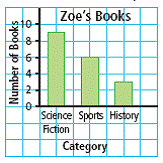 |
|||||||
| base of prism | Any face of a prism that reflects the general shape of the prism. (See page(s) 246) |
|||||||
| circle graph | A graph that represents data using sections of a circle. The sum of the percents in a circle graph is 100%.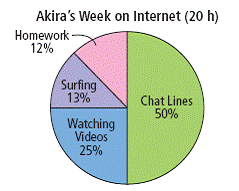 |
|||||||
| combined percents | Adding individual percents together. |
|||||||
| commutative property | The order of adding or multiplying quantities does not affect the result. a + b = b + a a x b = b x a |
|||||||
| constant | A number that does not change. |
|||||||
| cylinder | A three-dimensional object with two parallel and congruent circular bases.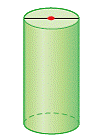 (See page(s) 182) |
|||||||
| distort | To change the appearance or twist the meaning of something in a way that is misleading. |
|||||||
| distributive property | Multiplication of each term inside the brackets of an expression by the term outside the brackets: a(b + c) = a x b + a x c = ab + ac |
|||||||
| double bar graph | A graph that uses two sets of horizontal or vertical bars to compare two sets of data across categories.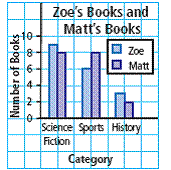 |
|||||||
| double line graph | A graph that uses two lines to represent changes of two sets of data over time.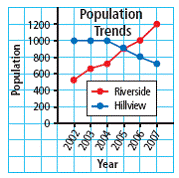 |
|||||||
| edge | A line segment where two faces meet.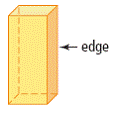 |
|||||||
| equation | A mathematical statement with two expressions that have the same value. The two expressions are separated by an equal sign. 3a – 2 = 4 is an equation. |
|||||||
| expression | Any single number, single variable, or combination of operations ( +, –, ×, ÷) involving numbers and variables. An expression does not include an equal sign. x + 9,
2y – 7, 8t, and 5 are expressions. |
|||||||
| face | A flat or curved surface.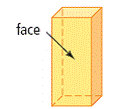 |
|||||||
| favourable outcome | A successful result in a probability experiment. |
|||||||
| formula | A mathematical statement that represents the relationship between specific quantities. An example is C = ?? × d, where C is the circumference and d is the diameter of a circle. |
|||||||
| fractional percent |
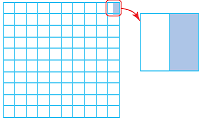 (See page(s) 126) |
|||||||
| height | The perpendicular distance from the base to the opposite side. Common symbol is h. (See page(s) 246) |
|||||||
| hypotenuse | The longest side of a right angle triangle. Opposite the right angle. (See page(s) 89) |
|||||||
| improper fraction |
|
|||||||
| independent events | Results in which the outcome of one event has no effect on the outcome of another event. |
|||||||
| integer | Any of the numbers ..., –3, –2, –1, 0, 1, 2, 3, ... (See page(s) 410) |
|||||||
| interval | The spread between the smallest and the largest numbers in a range of numbers. (See page(s) 6) |
|||||||
| line graph | A graph that uses a line to represent changes in data over time.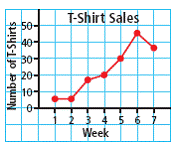 |
|||||||
| linear equation | An equation that, when graphed, results in points that lie along a straight line. (See page(s) 371) |
|||||||
| linear relation | A pattern made by a set of points that lie in a straight line.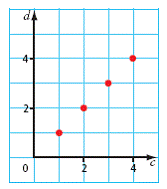 |
|||||||
| mixed number |
|
|||||||
| net | A two-dimensional figure, that, when folded, encloses a 3-D object. (See page(s) 170) |
|||||||
| numerical coefficient | A number that multiplies the variable. In 2x + 4, the number 2 is the numerical coefficient. |
|||||||
| opposite operation | A mathematical operation that undoes another operation. Subtraction and addition are opposite operations; multiplication and division are opposite operations. Also called inverse operation. |
|||||||
| order of operations | The correct sequence of steps for a calculation. Brackets first, then multiply and divide in order from left to right, and then add and subtract in order from left to right. |
|||||||
| orientation | The different position of an object formed by translating, rotating, or reflecting the object. (See page(s) 248) |
|||||||
| part-to-part ratio | Compare different parts of a group to each other. (See page(s) 48) |
|||||||
| part-to-whole ratio |
(See page(s) 48) |
|||||||
| percent |
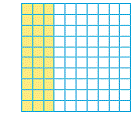 (See page(s) 122) |
|||||||
| perfect square | A number that is the product of two identical factors. It has an even number of prime factors. 2 × 2 = 4 is a perfect square. 2 × 2 × 3 × 3 = 36, so 36 is a perfect square. (See page(s) 82) |
|||||||
| pictograph | A graph that illustrates data using pictures and symbols.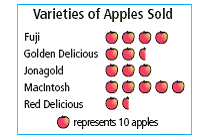 |
|||||||
| plane | A two-dimensional flat surface that extends in all directions. |
|||||||
| prime factorization | A number written as the product of its prime factors. The prime factorization of 6 is 2 × 3. (See page(s) 82) |
|||||||
| probability | The likelihood or chance of an event occurring. Probability can be expressed as a ration, a fraction, or a percent. (See page(s) 410) |
|||||||
| proper fraction |
|
|||||||
| proportion |
(See page(s) 64) |
|||||||
| Pythagorean relationship | The relationship between the lengths of the sides of a right triangle. The sum of the areas of the squares attached to the legs of the triangle equals the area of the square attached to the hypotenuse.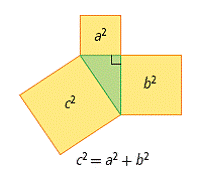 (See page(s) 90) |
|||||||
| rate | A comparison of two quantities measured in different units. $1.69 per 100 grams or $1.69/11 g is a rate for purchasing bulk food. 72 beats per minute or 72 beats/min is a heart rate. (See page(s) 55) |
|||||||
| reciprocal |
(See page(s) 224) |
|||||||
| rectangular prism | A prism whose bases are congruent rectangles. (See page(s) 170) |
|||||||
| right prism | A prism that has sides that are perpendicular to the bases of the prism. |
|||||||
| sample space | All possible outcomes of a probability experiment. (See page(s) 411) |
|||||||
| sign rules | In division, the quotient of two integers with the same sign is positive, and with different signs is negative. In multiplication, the product of two integers with the same sign is positive, and with different signs is negative. (See page(s) 294) |
|||||||
| square root | A number that when multiplied by itself equals a given value. The symbol is  (See page(s) 83) |
|||||||
| surface area | The number of square units needed to cover a 3-D object. The sum of the areas of all the faces of an object.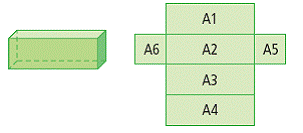 (See page(s) 177) |
|||||||
| table of values | A chart showing two sets of related numbers. |
|||||||
| tessellation | A pattern that covers an area or plane without overlapping or leaving gaps. Also called a tiling pattern.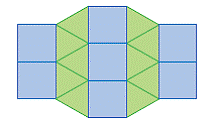 (See page(s) 446) |
|||||||
| three-term ratio | Compares three quantities measured in the same units. Can be written as a : b : c, or a to b to c.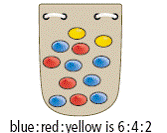 (See page(s) 47) |
|||||||
| tiling pattern | A pattern that covers an area or plane without overlapping or leaving gaps. Also called a tessellation. (See page(s) 446) |
|||||||
| tiling the plane | Using repeated congruent figures to cover an area without leaving gaps or overlapping. (See page(s) 446) |
|||||||
| transformation | A change in a figure that results in a different position or orientation. Examples are transformations, reflections, and rotations. (See page(s) 452) |
|||||||
| trend | The general direction in which a line graph is going. |
|||||||
| triangular prism | A prism with two triangular faces that are the same size and shape.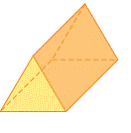 (See page(s) 172) |
|||||||
| two-term-ratio | Compares two quantities measured in the same units. Can be written as
a : b or a to b.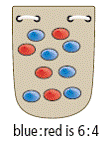 (See page(s) 47) |
|||||||
| unit price | A unit rate that involves prices. Often shown per 100 g or 100 mL. $5.00 per 100 g is a unit price. (See page(s) 58) |
|||||||
| unit rate | A rate in which the second term is 1. 64 beats/min is a unit rate. (See page(s) 56) |
|||||||
| variable | A letter that represents an unknown number. In 3a – 5, the variable is a. |
|||||||
| vertex | The point where three or more edges of a figure meet. The plural is vertices.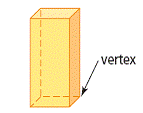 |
|||||||
| volume | The amount of space an object occupies. Measured in cubic units. (See page(s) 247) |
|||||||
| zero pair | A pair of integer chips with one chip representing +1 and one chip representing –1. The pair represents zero because (+1) + (–1) = 0. Any whole number of zero pairs represents zero. |
|||||||
|
Here are some interesting projects you might enjoy trying as you work through MathLinks 8. Do them alone or in a group.
To do some of these projects, you may wish to use the special paper that has been provided online. Also, there are Web Links to help you access necessary information. Project Ideas Master Sheets Project Ideas Web Links Representing Data Project #1 - Creating a circle graph using technology National Center for Education Statistics (NCES) Provides templates to create different types of graphs including circle graphs. Provides lots of options. Includes a tutorial. ( http://nces.ed.gov/nceskids/createagraph/default.aspx ) Representing Data Project #1 - Creating a hand-drawn circle graph Syracuse University Center for the Support of Teaching and Learning (CSTL) Provides detailed instructions for constructing a hand-drawn circle graph. Illustrates using percent to create each sector. ( http://cstl.syr.edu/fipse/TabBar/BldCirc/BUILDCIR.HTM ) Representing Data Project #2 - Reading an electric or gas meter
http://www.utilitiesconsumeradvocate.gov.ab.ca/88.html Government of Alberta Explains how to read dial electric and gas meters in Alberta. Includes a link to using energy wisely. ( http://www.utilitiesconsumeradvocate.gov.ab.ca/88.html ) http://www.directenergy.com/EN/Texas/RES/Pages/CUS/HowToReadYourMeter.aspx Direct Energy Explains how to read a dial electric meter. Includes a link to reducing energy costs. ( http://www.directenergy.com/EN/Texas/RES/Pages/CUS/HowToReadYourMeter.aspx ) http://www.epcor.ca/en-ca/Customers/electricity-customers/MeterReading/Pages/ElectricMeterRead.aspx EPCOR Explains how to read different types of digital electric meters. ( http://www.epcor.ca/en-ca/Customers/electricity-customers/MeterReading/Pages/ElectricMeterRead.aspx ) Representing Data Projects #2 and #3 - How to choose which type of graph to use National Center for Education Statistics (NCES) Provides a tutorial about which types of graphs to use to display certain types of data. ( http://nces.ed.gov/nceskids/help/user_guide/graph/whentouse.asp ) Number Relations Project #1 - The Golden Rectangle About.com Provides information about the Golden Rectangle and how to find it based on the golden ratio. ( http://altreligion.about.com/library/glossary/symbols/bldefsgoldenrectangle.htm ) Number Relations Project #1 - The Golden Section and the human body Rasko Jovanovic’s World of Mathematics Illustrates several examples of the Golden Section in the human body. ( http://milan.milanovic.org/math/english/golden/golden2.html ) Number Relations Project #3 - How to choose which type of graph to use National Center for Education Statistics (NCES) Provides a tutorial about which types of graphs to use to display certain types of data. ( http://nces.ed.gov/nceskids/help/user_guide/graph/whentouse.asp ) Number Relations Project #3 - Benford’s Law Millennium Mathematics Project Discusses the occurrence of digits in lists of naturally occurring numbers. Features Benford’s Law. ( http://plus.maths.org/issue9/features/benford/ ) Number Relations Project #4 - The Swahili clock MetaFilter Network Provides background information about the Swahili clock. ( http://www.metafilter.com/69359/The-worlds-first-Swahili-clock ) Pythagorean Relationships Project #3 - Investigating the Pythagorean relationship Janet Mae Zahumeny Includes geometry software activities involving shapes other than squares to explore the Pythagorean relationship. Version 3 of The Geometer’s Sketchpad is needed for this activity. ( http://www.wpunj.edu/icip/itm/Lessonpl/sketch/pythag.html ) Three-Dimensional Figures Project #1 - Interactive activity for changing the height and radius of a cylinder Maris Technologies Ltd. Provides an applet that allows users to change the height and radius of a cylinder and discover that for minimum surface area with a fixed volume, the height must be double the radius. ( http://www.maris.com/content/applets/math/SodaCanDemo.html ) Three-Dimensional Figures Project #2 - Defines pyramid Wise Geek Defines pyramid. ( http://www.wisegeek.com/what-is-a-pyramid.htm ) Three-Dimensional Figures Project #2 - The rhomboidal pyramid called the Bent Pyramid at Dahshur
http://www.pyramidmatrix.com/bent_pyramid.htm Carl Munck Provides background information about the rhomboidal pyramid and why it was built using this shape. ( http://www.pyramidmatrix.com/bent_pyramid.htm ) http://www.narmer.pl/pir/snofru_en.htm Darius Sitek Scroll down for dimensions of the Bent Pyramid at Dahshur. ( http://www.narmer.pl/pir/snofru_en.htm ) Three-Dimensional Figures Project #3 - Nets of a truncated icosahedron (soccer ball) G. Korthals Altes Scroll down for two versions of nets of a soccer ball. The PDF version is better. ( http://www.korthalsaltes.com/football.html ) Three-Dimensional Figures Project #3 - The buckyball and truncated icosahedrons
http://www.seed.slb.com/en/scictr/lab/buckyball/index.htm Schlumberger Excellence in Educational Development (SEED) Provides information about the buckyball. Provides instructions for building a paper model of a truncated icosahedron. ( http://www.seed.slb.com/en/scictr/lab/buckyball/index.htm ) http://www.3dchem.com/molecules.asp?ID=217 Karl Harrison Provides information about a buckyball molecule. Allows users to interact with a 3-D model. ( http://www.3dchem.com/molecules.asp?ID=217 ) http://www.chem.wisc.edu/~newtrad/CurrRef/BDGTopic/BDGtext/bmmbas.html Malcolm W. Browne New York Times Provides information about the applications of the buckyball molecule in chemistry. ( http://www.chem.wisc.edu/~newtrad/CurrRef/BDGTopic/BDGtext/bmmbas.html ) Three-Dimensional Figures Project #4 - Photograph of a step pyramid Official site of Dr. Zahi Hawass Shows a photo of the Step Pyramid at Saqqara. ( http://www.guardians.net/hawass/Press%20Releases/laser_survey_step_pyramid.htm ) Probability Project #2 - How to choose which type of graph to use National Center for Education Statistics (NCES) Provides a tutorial about which types of graphs to use to display certain types of data. ( http://nces.ed.gov/nceskids/help/user_guide/graph/whentouse.asp ) Tessellations Project #1 - Picture gallery featuring M. C. Escher’s works Official Site of M.C. Escher Provides links to view some of M. C. Escher’s works, including Sky and Water. ( http://www.mcescher.com/Gallery/gallery-switz.htm ) Tessellations Project #2 - Tessellating a plane The Math Forum: Drexel University Defines tessellations. Provides ideas on creating shapes that will tessellate the plane. ( http://mathforum.org/sum95/suzanne/whattess.html ) |
|
Do you want to do better in math? We have some suggestions that will help you.
Tips for Students Why Studying Math is Different · Reading a math text is not like reading a novel. You may have to stop and think about some lines before proceeding. · Math is a cumulative subject. If you miss a concept one day, it may come back to haunt you and could even prevent you from understanding concepts you study later. Always get help as soon as you recognize that you have a problem. · Build up a network of math partners you can consult if you run into a roadblock. These are the days of easy communication. Telephone, email, and instant messaging are all available. Use them. · Take responsibility for your own success. If you find that you don't know or understand something, take whatever steps are necessary to fix the problem. Do not let others distract you from your purpose. · Be an active participant in the classroom. Volunteer answers to questions and offer to place solutions on the blackboard. Ask questions immediately when you think you have lost the thread of the lesson. · Math is learned by doing problems. Although you need to know some facts and procedures, you get really good at math by working through problems. It's wise to work on a problem yourself as much as possible. You may need to ask for help at some point, but don't give up too easily. The more you can do on your own, the more your brain will develop and the easier future problems will seem. · Problem-solving is one of the key skills in the study of math. There are tips for problem-solving starting on page xiii in the front of MathLinks 8. Your teacher will show you additional strategies that you can use. In short, the steps are: · Before beginning an assignment, review your class notes. Ensure that you understand the worked examples and the meaning of any new terms. Consider highlighting important concepts, equations, or definitions. · As you work on each chapter, use the Foldables™ idea at the beginning of that chapter to keep track of information from the chapter, including Key Words, examples, Key Ideas, and what you need to work on. · If you have completed the assigned problems, but still don't feel comfortable with the concepts, do a few more. Most teachers will assign about half of the problems in a given exercise. If you run out of practice questions before you feel comfortable with the concepts, ask the teacher for more. This Student Centre section of the MathLinks 8 Online Learning Centre has many things to help you. · If you find that you need some help or a hint to proceed with the solution to a problem, be careful not to get too much help. You want a coach, not a handout. Once you see where to go, thank your coach. Don't ask for the entire solution. That robs you of an important learning opportunity. · You have not failed at solving a question until you quit. Sometimes it is useful to skip a tricky question after thinking about it for a few minutes and then come back to it later. · If there is any reason why you cannot finish your entire math assignment, it is better to do a few problems from each part than to do just the first problems in the assignment. · If the homework load is light on a given day, use the extra time to review and practise concepts covered earlier in the course. · Allow a few minutes at the end of your math work session to have a look at the next lesson so that you know what is coming up. It isn't necessary to work through the lesson, just to get a feeling for what is going to happen in the next math class. · If you do your homework conscientiously and work at fixing problems as they occur, then preparing for tests becomes much easier. All you need to do is remind yourself of the concepts that you are going to be tested on and do some sample problems to sharpen up your skills. · When you receive your test, take a minute or two to look it over. You don't have to do question #1 first. If you see that you know how to attack question #3, then do that one first. · Don't get bogged down on a question. If your strategy doesn't seem to be working and you are stuck for an alternative, go on to another question. · Sometimes you will not finish a test in the time allotted. If this seems to be happening, do not panic. Accept that you are not going to finish. Make it your goal to do as many questions as you can before the time runs out. · Read each question carefully. Be sure that you answer what was asked. · Be sure to show your work. If you make an error and arrive at the wrong answer, you will at least get partial marks. · If you have time left, use it to verify your answers. You can sometimes work backwards to do this. Alternatively, you can solve the same question a different way. Be sure to check calculations. A slip of the finger on a calculator can easily lead to a wrong answer. · Watch out for panic attacks or "freezeups". This occasionally happens to many students on a test. Time may be short, solutions are not going well, and you have an overwhelming sense of panic. The best thing to do is STOP. Turn the test over on your desk. Take several deep breaths, exhaling slowly. Remind yourself that you prepared for this test and that you can do most, probably all, of the questions on it. Then, return to the test, select a question that you can do, and work through it. · If panic becomes a serious problem, consider learning one or more relaxation techniques or consulting a counsellor for other strategies. Keep in mind that these will not help if the real source of the panic is inadequate preparation for the test. |
| Place It! |
||
| http://www.mathsisfun.com/games/place-it.html | ||
| This two-dimensional geometry game called Place It! tests your spatial sense by requiring you to assemble a square from odd-shaped pieces. The number of pieces can be varied to adjust the difficulty of the game. Players play against the clock to determine winners and losers. ( http://www.mathsisfun.com/games/place-it.html ) |
||
| Mathematics and Computation: The Hydra Game |
||
| http://math.andrej.com/2008/02/02/the-hydra-game/ | ||
| Based on the creature from Greek mythology with many heads, the hydra, this is sometimes billed as “the game you can’t lose”. Although this claim refers only to the fact that every variation of the game has a solution, there is a fair amount of strategy involved in determining the solution in a minimum number of steps, allowing for competition among players. Winning strategies require good number sense, and will sharpen your numerical skills. ( http://math.andrej.com/2008/02/02/the-hydra-game/ ) |
||
| Let’s Make a Deal |
||
| http://math.ucsd.edu/~crypto/Monty/monty.html | ||
| Based on a popular television program, Let’s Make a Deal requires you to make a selection, and then, decide whether to switch your selection based on information provided by the computer. The strategy that helps you to win is based on probability, and can be deduced using tools that you learn in this course. ( http://math.ucsd.edu/~crypto/Monty/monty.html ) |
||
| Playing With JAVA: The Chomp Game |
||
| http://lpcs.math.msu.su/~pentus/abacus.htm | ||
| In an unusual twist, the first step in The Chomp Game requires you to deduce the rules. Once you have done so, you can play the game. Any number can play. ( http://lpcs.math.msu.su/~pentus/abacus.htm ) |
||
| Linear Lasers |
||
| http://mathforum.org/te/exchange/hosted/linearlasers/ | ||
| Polish your skills at visualizing linear relations in the context of a game. Given two targets, you must correctly construct the linear equation that will hit both targets. ( http://mathforum.org/te/exchange/hosted/linearlasers/ ) |
||
| Factor Game |
||
| http://illuminations.nctm.org/ActivityDetail.aspx?ID=12 | ||
| Need some practice before tackling fraction operations? The Factor Game allows two players to compete against each other while brushing up on factoring skills needed for a variety of mathematics topics, including fraction operations. You can also play against the computer. ( http://illuminations.nctm.org/ActivityDetail.aspx?ID=12 ) |
||
| The All New & Improved Fruit Game! |
||
| http://www.2020tech.com/fruit/index.html | ||
| The Fruit Game is an interactive Nim-type game. Several kinds of fruit are placed on the table. You may go first, or tell the computer to go first. You, or the computer, “eat” as many of one kind of fruit as you like per turn. The object is to beat the computer by removing the last piece of fruit from the table. ( http://www.2020tech.com/fruit/index.html ) |
||
| Hammurabi–Long Live the King! |
||
| http://maddrio.com/hammurabi/hammurabi.php | ||
| Hammurabi is a game based on the Babylonian King, Hammurabi who is credited with the first code of law. You are placed in charge of the kingdom for ten years and must make economic decisions each year of your reign. The computer calculates the results of your decisions, along with some random factors that you cannot control. The objective is to end your reign with the kingdom in a better state than when you started. ( http://maddrio.com/hammurabi/hammurabi.php ) |
||
| The Chaos Game |
||
| http://math.bu.edu/DYSYS/applets/chaos-game.html | ||
| The Chaos Game makes use of the Sierpinski Triangle and some of the Chaos Theory behind the generation of fractals to present a challenging puzzle. There are four levels of difficulty provided. ( http://math.bu.edu/DYSYS/applets/chaos-game.html ) |
||
| What is the Game of Life? |
||
| http://www.math.com/students/wonders/life/life.html | ||
| The Game of Life uses biological growth patterns as well as mathematical patterning to create a simulation of the growth or death of a culture. There are several rules for survival, which you can mix and match. The object is to create a living system that is able to sustain itself. ( http://www.math.com/students/wonders/life/life.html ) |
||
| Hex-7 |
||
| http://www.mazeworks.com/hex7/index.htm | ||
| Hex-7 is a strategy game that requires players to build a path across a playing surface made up of hexagons. You play against the computer and have the choice of first or second move. The game is offered at novice and advanced levels. ( http://www.mazeworks.com/hex7/index.htm ) |
||
| Hare and Hounds |
||
| http://www.math.com/students/puzzles/hare/hare.html | ||
| Hare and Hounds is a strategy game that was popular among military officers in France during the 1800s. You can select hare or hounds. The hare must elude the hounds and escape. The hounds must trap the hare so that it cannot move. The game is offered at beginner and advanced levels. ( http://www.math.com/students/puzzles/hare/hare.html ) |
||
| Hidden Picture |
||
| http://www.aplusmath.com/cgi-bin/games/geopicture | ||
| This is a variation of a memory game. You must correctly identify geometric terms to reveal pieces of a hidden picture. Several pictures are available. ( http://www.aplusmath.com/cgi-bin/games/geopicture ) |
||
| Rubik Unbound |
||
| http://www.javaonthebrain.com/java/rubik/ | ||
| The applet allows you to manipulate a Rubik’s cube in three dimensions. The applet will randomly scramble the cube for you. ( http://www.javaonthebrain.com/java/rubik/ ) |
||
| Gomoku Board Game Online |
||
| http://www.checkers.ws/board_games/gomoku/gomoku_online.htm | ||
| Gomoku is a version of Tic Tac Toe that is played on an infinite game space and requires the winner to get five spheres in a row. You play against the computer. The game board can be resized. ( http://www.checkers.ws/board_games/gomoku/gomoku_online.htm ) |
||
| Web Sudoku |
||
| http://www.websudoku.com/ | ||
| Sudoku is a classic numbers game that requires you to complete a puzzle using the integers 1 to 9. Once you have mastered the Easy level, you can proceed through Medium and Hard to Evil levels. ( http://www.websudoku.com/ ) |
||
Your class is ordering a cake for a celebration and wants to know how many people prefer chocolate or vanilla. One student volunteers to use a graph to organize and compare the data. The class prefers chocolate but the graph seems to show that most people prefer vanilla. How could that student have misrepresented the data to get the vanilla cake the student wanted? Take a tour around this site to find out. |
|
Chapter 1 Representing Data Yes or No The 450 students at Ridgeway High School were each given a questionnaire to choose the act that would be booked for the next assembly.
  Each student was asked to circle one answer for each question and to choose only one first-choice act. Some students did not follow instructions and chose two first-choice acts.
When the results were tallied, there were 220 yes answers for the magician, 180 yes answers for the acrobats, and 100 yes answers for the comedian. How many students chose two first-choice acts? How many of the students chose one first-choice act? Click here for a hint Click here for the solution Note: Brain teasers are often open to more than one interpretation, and multiple answers may be possible. Sample solutions are shown.
|
|
Want a fun way to test your knowledge of math terms? Try this Crossword Puzzle and see how many you can get!
|
|
Line ’Em Up (2–4 Players) Materials Needed: • small counters in a different colour per player • one eight-sided die and one twelve-sided die • 1. Print the game board on BLM: Line ’Em Up. 2. Distribute counters to each player. 3. The first player rolls the twelve-sided die to determine an x-coordinate and then the eight-sided die to determine a y-coordinate. The player places the counter on the appropriate point on the playing board. 4. Play moves to the next player who rolls the dice and places a counter on the game board. Play continues clockwise. Note: More than one counter may occupy a point on the playing board. If this happens, stack the counters on the point. 5. Players continue rolling the dice until the end of the round. The round ends when a player has three counters that show a linear relationship, forming a straight line diagonally, horizontally, or vertically. 6. The first player to identify the linear relationship wins the round and receives 1 point. The counters are cleared off the board for the next round. Play continues for as many rounds as players wish. 7. The winner is the player with the highest number of points. |
|
Line ’Em Up (2–4 Players) Materials Needed:
• small counters in a different colour per player
• one eight-sided die and one twelve-sided die • 1. Print the game board on BLM: Line ’Em Up.
2. Distribute counters to each player.
3. The first player rolls the twelve-sided die to determine an x-coordinate and then the eight-sided die to determine a y-coordinate. The player places the counter on the appropriate point on the playing board.
4. Play moves to the next player who rolls the dice and places a counter on the game
board. Play continues clockwise.
Note: More than one counter may occupy a point on the playing board. If this happens, stack the counters on the point. 5. Players continue rolling the dice until the end of the round. The round ends when a player has three counters that show a linear relationship, forming a straight line diagonally, horizontally, or vertically.
6. The first player to identify the linear relationship wins the round and receives 1 point. The counters are cleared off the board for the next round. Play continues for as many rounds as players wish.
7. The winner is the player with the highest number of points.
|
| USATODAY.com | ||
| Provides data about the 20 top-selling digital tracks with their corresponding rank on the year-end national airplay and mastertone charts. ( http://www.usatoday.com/life/music/news/2007-01-04-music-sales-side_x.htm ) |
||
Chapter 2 Student Book
Student Book (PDF)
|
Chapter 2 Ratios, Rates, and Proportional Reasoning Father and Son Today, Mr. Morgan is twice as old as his nephew. Twenty-five years ago, the ratio of their ages was 3 : 1. When will Mr. Morgan be 100 years old?
Click here for a hint Click here for the solution Note: Brain teasers are often open to more than one interpretation, and multiple answers may be possible. Sample solutions are shown.
|
|
Want a fun way to test your knowledge of math terms? Try this Crossword Puzzle and see how many you can get!
|
|
At Any Ratio (2–4 Players) Materials Needed: • deck of playing cards • two twelve-sided dice 1. Remove the kings from the deck of cards. One player deals the remaining cards equally to each player. • Aces represent 1s, jacks represent 11s, and queens represent 12s. • Other cards represent their face numbers. 2. Each player begins with 10 points. Each player rolls one die to decide who will play first. The player with the highest roll goes first. If there is a tie, roll again. 3. The first player rolls the two dice and determines the ratio between the two numbers rolled. The player looks for cards in his or her hand that form an equivalent ratio in lowest terms. Any cards that show the same ratio in lowest terms are placed on the table. Example: Sunita rolls the ratio 8 : 12. She has a 2 and a 3 in her hand. This is the ratio of 8 : 12 expressed in lowest terms. She puts the 2 and the 3 on the table. 4. The other players check the cards on the table. If the ratio is correct and is in lowest terms, the player is awarded 1 point. If the ratio is incorrect, or is not in lowest terms, the player loses 1 point. 5. Play moves to the next player. Play ends when one player runs out of cards or after an agreed upon time limit. The winner is the player with the most points at the end of the game. |
|
At Any Ratio (2–4 Players) Materials Needed:
• deck of playing cards
• two twelve-sided dice 1. Remove the kings from the deck of cards. One player deals the remaining cards equally to each player.
• Aces represent 1s, jacks represent 11s, and queens represent 12s. • Other cards represent their face numbers. 2. Each player begins with 10 points. Each player rolls one die to decide who will play first. The player with the highest roll goes first. If there is a tie, roll again.
3. The first player rolls the two dice and determines the ratio between the two numbers rolled. The player looks for cards in his or her hand that form an equivalent ratio in lowest terms. Any cards that show the same ratio in lowest terms are placed on the table.
Example: Sunita rolls the ratio 8 : 12. She has a 2 and a 3 in her hand. This is the ratio of 8 : 12 expressed in lowest terms. She puts the 2 and the 3 on the table. 4. The other players check the cards on the table. If the ratio is correct and is in lowest terms, the player is awarded 1 point. If the ratio is incorrect, or is not in lowest terms, the player loses 1 point.
5. Play moves to the next player. Play ends when one player runs out of cards or after an agreed upon time limit. The winner is the player with the most points at the end of the game.
|
| SE page 45 Information about Folklorama® |
||
| Folk Arts Council of Winnipeg | ||
| Provides news articles and a calendar of events. ( http://www.folklorama.ca/ ) |
||
| SE page 53 Practise solving ratio problems |
||
| National Council of Teachers of Mathematics | ||
| Provides several ratio problems. ( http://www.figurethis.org/challenges/c25/challenge.htm ) |
||
| SE page 54 Information about the golden ratio in nature, architecture, art, poetry, and music |
||
| Oracle Education Foundation |
||
| Information and visuals about the golden ratio in architecture including The Parthenon and the Great Pyramids of Giza. (http://library.thinkquest.org/trio/TTQ05063/phibeauty4.htm) |
||
| University of Georgia | ||
| This site was developed by J. Wilson. Information about the golden ratio including a brief history, definitions, golden geometry, and the golden ratio in art and architecture. ( http://jwilson.coe.uga.edu/EMT668/EMAT6680.2000/Obara/Emat6690/Golden%20Ratio/golden.html ) |
||
| Department of Mathematics, Surrey University, Guildford, UK | ||
| This site was developed by R. Knott. Information about the golden ratio in architecture, art, and music. Includes a Things to Do investigation about logos that are golden rectangles and numerous active links. ( http://www.mcs.surrey.ac.uk/Personal/R.Knott/Fibonacci/fibInArt.html ) |
||
| SE page 73 International food recipes |
||
| CooksRecipes.com | ||
| Provides recipes by category and by country or region. ( http://www.cooksrecipes.com/category/international.html ) |
||
Digital cameras are great because they allow you to crop, enhance, and edit the photos that you take. Every time you enlarge or reduce a photo, you are using ratios. Learn more about ratios with the games and tools this site provides. |
Chapter 3 Student Book
Student Book (PDF)
|
Chapter 3 Pythagorean Relationship Paper Roll A cardboard cylinder has a circumference of 12 cm and a length of 20 cm. Ranjeet started at the top of the roll and drew a line all the way around the roll. He completed four turns before reaching the bottom, as shown in the picture. How long was the line that Ranjeet drew?
 Click here for a hint Click here for the solution Note: Brain teasers are often open to more than one interpretation, and multiple answers may be possible. Sample solutions are shown.
|
|
Want a fun way to test your knowledge of math terms? Try this Crossword Puzzle and see how many you can get!
|
|
Square Cuts (Any Number of Players) Materials Needed: • sheet of paper per player • ruler per player • scissors per pair of players • coloured pencils • timer 1. On a sheet of paper, each player draws a right triangle of any size. A square is drawn on each of the two sides and the hypotenuse of the triangle. The squares are cut out and the right triangle is set aside. 2. Divide each square into five shapes by drawing straight lines. Each shape is coloured such that no two touching shapes are the same colour. 3. Cut out the coloured shapes by cutting along the lines, mix up the shapes, and pass the shapes to the player on the right. 4. Start the timer. Each player needs to reassemble the shapes back into the original squares such that the squares form the sides of a right triangle. Each player records the time it took to reassemble the original squares. Stop the timer when all players are done. 5. The score for each player is 300 – t, where t is the time required to reassemble the shapes, in seconds. 6. The winner is the player with the highest score. |
|
Square Cuts (Any Number of Players) Materials Needed:
• sheet of paper per player
• ruler per player • scissors per pair of players • coloured pencils • timer 1. On a sheet of paper, each player draws a right triangle of any size. A square is drawn on each of the two sides and the hypotenuse of the triangle. The squares are cut out and the right triangle is set aside.
2. Divide each square into five shapes by drawing straight lines. Each shape is coloured such that no two touching shapes are the same colour.
3. Cut out the coloured shapes by cutting along the lines, mix up the shapes, and pass the shapes to the player on the right.
4. Start the timer. Each player needs to reassemble the shapes back into the original squares such that the squares form the sides of a right triangle. Each player records the time it took to reassemble the original squares. Stop the timer when all players are done.
5. The score for each player is 300 – t, where t is the time required to reassemble the shapes, in seconds.
6. The winner is the player with the highest score.
|
| SE page 79 Information about the game of Playing Leader |
||
| NativeTech | ||
| Native American Technology and Art Provides a description and a visual of the game. ( http://www.nativetech.org/games/boardgames.html ) |
||
| SE page 91 Explore the Pythagorean relationship |
||
| Mission: Algebra | ||
| Explore nine interactive proofs for the Pythagorean Theorem. ( http://www.ies.co.jp/math/java/geo/pythagoras.html ) |
||
If you walk from your house to school, it’s useful to know the shortest distance. How much farther do you have to walk because you cannot take shortcuts through private property? The Pythagorean relationship can be used for such things as calculating the shortest route to school, compared to the route you have to walk. Learn more about Pythagoras, right triangles, and square roots on this site. |
Chapter 4 Student Book
Student Book (PDF)
|
Chapter 4 Understanding Percent Ping Pong Challenge Sandy’s Sports Shop offered its customers a chance to win a new bicycle by guessing how many ping pong balls were in a large jar. Andy guessed 150. Bea guessed 20% higher than Andy. Denys guessed 25% higher than Bea. Emma guessed 20% lower than Denys. Francesca guessed 10% lower Emma. Chandra guessed 50% higher than Francesca. Chandra guessed correctly and won the bicycle. How many ping pong balls were in the jar?
Click here for a hint Click here for the solution Note: Brain teasers are often open to more than one interpretation, and multiple answers may be possible. Sample solutions are shown.
|
|
Want a fun way to test your knowledge of math terms? Try this Crossword Puzzle and see how many you can get!
|
|
Nail the Percent (2–4 Players) Materials Needed: • two paper clips • two pencils • timer • calculator • 1. Print and cut out the spinners on BLM: Spinners. Use the paper clips and pencils to complete the spinners. 2. The first player spins both spinners. The player to the left starts the timer. 3. The first player places the smallest number spun over the largest number to form a fraction. If the numbers are equal, place either one over the other. If two zeroes are spun, the player receives 5 points, and play moves to the next player. 4. The player has 10 s to estimate the percent that is equivalent to the fraction. Points are awarded according to the table.  Example: The fraction is  5. Play moves to the next player. The player to the left is the timer. 6. End the game after 20 rounds. The winner is the player with the highest score. |
|
Nail the Percent (2–4 Players) Materials Needed: 1. Print and cut out the spinners on BLM: Spinners. Use the paper clips and pencils to complete the spinners.
2. The first player spins both spinners. The player to the left starts the timer.
3. The first player places the smallest number spun over the largest number to form a fraction. If the numbers are equal, place either one over the other. If two zeroes are spun, the player receives 5 points, and play moves to the next player.
4. The player has 10 s to estimate the percent that is equivalent to the fraction. Points are awarded according to the table.
Example: The fraction is . The player estimates the equivalent percent is 39%. The player uses the calculator to check the correct answer of 37.5%. The player receives 1 point for the answer since it is within 2% of the correct answer. 5. Play moves to the next player. The player to the left is the timer.
6. End the game after 20 rounds. The winner is the player with the highest score.
|
| SE page 143 Data and tips about conserving water |
||
| American Water Works Association | ||
| Provides conservation tips at home. From the list on the left, click on Conservation Outside for outdoor conservation tips and click on Water Use Statistics for data about water use. ( http://www.drinktap.org/consumerdnn/Default.aspx?tabid=83 ) |
||
| SE page 145 PST rates by province |
||
| Taxtips.ca | ||
| Provides information about PST rates by province or territory. Use the active links for more information about provinces that charge PST. ( http://www.taxtips.ca/pst/pstrates.htm ) |
||
When you go shopping, GST and PST are often added to the price of an item. These taxes are a percent of the cost of the item. Although the GST rate is the same across the country, some parts of Canada charge more PST than others. That means you might pay a lot more or less than someone else in Canada for what you are buying. Learn more about taxes and percents as you explore the many activities this site provides. |
Chapter 5 Student Book
Student Book (PDF)
|
Chapter 5 Surface Area The Round Table The Fung family eats dinner at a circular table that has an area of 20 096 cm2. They have invited several friends to dinner and need to double the area of the table to fit all of their guests. The table opens in the middle to allow rectangular leaves to be added. Each leaf is 30 cm wide and fits across the diameter of the table. What is the minimum number of leaves needed? Click here for a hint Click here for the solution Note: Brain teasers are often open to more than one interpretation, and multiple answers may be possible. Sample solutions are shown.
|
|
Want a fun way to test your knowledge of math terms? Try this Crossword Puzzle and see how many you can get!
|
|
Para Lelli Pipe Ed (Pairs of Players) Materials Needed: • scissors • tape • timer • Note: A parallelepiped is a six-sided figure with opposite sides parallel. A box is a parallelepiped with right-angled corners. 1. Print a copy of Master 8 Centimetre Grid Paper for each player. 2. Pairs of players choose a value for the surface area of a box that can be made using the grid paper, and tell their partner. 3. Start the timer. Working at the same time, the players have 5 min to • draw, cut out, and fold a box with the surface area chosen by their partner • prove that it is not possible to create a box with that surface area using the grid paper 4. At the end of 5 min, or earlier if both players agree, check the results. A player is awarded 1 point for a box that has been made correctly or for a valid argument that explains why it is not possible to make the box. 5. Play continues for as many rounds as players wish. The winner is the player with the highest score at the end of the game. |
|
Para Lelli Pipe Ed (Pairs of Players) Materials Needed:
• scissors
• tape • timer • Note: A parallelepiped is a six-sided figure with opposite sides parallel. A box is a parallelepiped with right-angled corners. 1. Print a copy of Master 8 Centimetre Grid Paper for each player.
2. Pairs of players choose a value for the surface area of a box that can be made using the grid paper, and tell their partner.
3. Start the timer. Working at the same time, the players have 5 min to
• draw, cut out, and fold a box with the surface area chosen by their partner • prove that it is not possible to create a box with that surface area using the grid paper 4. At the end of 5 min, or earlier if both players agree, check the results. A player is awarded 1 point for a box that has been made correctly or for a valid argument that explains why it is not possible to make the box.
5. Play continues for as many rounds as players wish. The winner is the player with the highest score at the end of the game.
|
You are painting stage props of several different shapes and need to figure out how much paint to buy. To do this, you have to understand how to calculate the surface area. This site will provide you with information on surface areas of many different geometric shapes and figures. |
Chapter 6 Student Book
Student Book (PDF)
|
Chapter 6 Fraction Operations Dartboard A dartboard has five concentric circles. The centre circle has a value of 1, the next ring has a value of      Click here for a hint Click here for the solution Note: Brain teasers are often open to more than one interpretation, and multiple answers may be possible. Sample solutions are shown.
|
|
Want a fun way to test your knowledge of math terms? Try this Crossword Puzzle and see how many you can get!
|
|
Clear the Fractions (2–4 Players) Materials Needed: • 1. Print and cut out the fraction cards on BLM: Fraction Cards. 2. Shuffle and deal eight fraction cards to each player. Place the rest face down in a pile. 3. Players inspect and arrange their cards. The object is to find groups of three fractions that are related by addition, subtraction, multiplication, or division. Example:   4. The first player examines the cards for as many groups of three cards as possible, and then places the groups on the table. If there are cards remaining in his or her hand, the player draws a card from the pile and the turn is over. Play moves to the next player on the left. 5. Play ends when • all the cards have been drawn from the pile, or • a player is able to place all of his or her cards on the table 6. The score for each player is 20 – n, where n is the number of cards remaining in a player’s hand at the end of the game. |
|
Clear the Fractions (2–4 Players) Materials Needed: 1. Print and cut out the fraction cards on BLM: Fraction Cards.
2. Shuffle and deal eight fraction cards to each player. Place the rest face down in a pile.
3. Players inspect and arrange their cards. The object is to find groups of three fractions that are related by addition, subtraction, multiplication, or division.
Note: The Wild Card may take on any fractional value between 0 and 1. 4. The first player examines the cards for as many groups of three cards as possible, and then places the groups on the table. If there are cards remaining in his or her hand, the player draws a card from the pile and the turn is over. Play moves to the next player on the left.
5. Play ends when
• all the cards have been drawn from the pile, or • a player is able to place all of his or her cards on the table 6. The score for each player is 20 – n, where n is the number of cards remaining in a player’s hand at the end of the game.
|
| SE page 216 Information about provincial and territorial flags |
||
| Flags of the World | ||
| Provides an image and an overview of each provincial and territorial flag. Click on Protocol Order of Provincial/Territorial Flags and then click on each province or territory in the list. ( http://flagspot.net/flags/ca_prtcl.html ) |
||
| Worldflags101.com | ||
| Provides an image and information about the ratio of the width to the length of each flag. From the list on the left, click on each provincial or territorial flag. ( http://www.worldflags101.com/canada/alberta.aspx ) |
||
| SE page 231 Information about Canada’s gold rushes and the life of Keish |
||
| Virtual Museum Canada | ||
| Profiles gold rush photographers who captured images that portray aspects of life in the Yukon during the Klondike Gold Rush. From the list on the right, click on Larss and Duclos for a portrait of Keish. ( http://www.virtualmuseum.ca/Exhibitions/Goldrushphoto/02english/02intro.html ) |
||
| Parks Canada | ||
| The National Historic Sites of Canada in the Klondike Provides information about the Klondike Gold Rush. ( http://www.pc.gc.ca/lhn-nhs/yt/klondike/index_e.asp ) |
||
| Barkerville Historic Town | ||
| From the list on the left, click on The History for historical information about Barkerville, the Gold Capital of British Columbia. Site also features information about local attractions and stage shows that re-enact the history of the region. ( http://www.barkerville.ca/newindex/index03.html ) |
||
| Virtual Museum Canada | ||
| Play the interactive Cariboo Gold Rush Adventure Game to find out more about the people, places, and events in the Cariboo Gold Rush of the 1860s. (http://www.museevirtuel-virtualmuseum.ca/Search.do?Ne=8647&lang=en&N=8249+8100+4294224481&ex=on&Qo=6) |
||
| BC Heritage | ||
| Features resources about the Cariboo Gold Rush. Trace the Overlanders journey to the Cariboo Gold Rush. Check out primary source material from BC Archives, which includes journals, letters, and memoirs of the Cariboo Gold Rush era. ( http://bcheritage.ca/cariboo/contents.htm ) |
||
| The Centre for Canadian Studies at Mount Allison University | ||
| Features the history of the Canadian North West Mounted Police and their role in the Yukon Gold Rush. (http://www.mta.ca/faculty/arts/canadian_studies/) |
||
| SE page 239 Canada’s ecozones |
||
| Evergreen |
||
| Provides an introduction to Canada’s ecozones. On the map, click on each individual ecozone to learn more. (http://www.evergreen.ca/en/resources/native-plants/canada-ecozones.sn#prairies) |
||
Fractions are used in many ways, such as in recipes, for telling the time, and in print ads. What activities in your daily life include the use of fractions? Take a look around this site to find out more information on fractions. |
Chapter 7 Student Book
Student Book (PDF)
|
Chapter 7 Volume Books for Africa  Rayyan collected used books to send to a library in Africa. The books she collected are: • 10 large hardcover books, each measuring 40 cm by 30 cm by 5 cm • 20 smaller hardcover books, each measuring 30 cm by 20 cm by 4 cm • 30 paperback books, each measuring 20 cm by 12 cm by 3 cm The post office sold cube-shaped boxes starting with a side length of 20 cm and increasing by 5 cm to a maximum of 75 cm. Estimate the side length of the smallest cube-shaped box that could hold all of the books. Why is it just an estimate? Click here for a hint Click here for the solution Note: Brain teasers are often open to more than one interpretation, and multiple answers may be possible. Sample solutions are shown.
|
|
Want a fun way to test your knowledge of math terms? Try this Crossword Puzzle and see how many you can get!
|
|
The Prism Grill (3 or More Players) Materials Needed: • one 12-sided die • pencil and paper • calculator for checking calculations • timer 1. Players form a circular arrangement around a playing table and agree to a time limit, such as 20 min, for the game. 2. Player 1 rolls the die three times and notes the number that comes up each time. These numbers represent the base, height, and length of a right triangular prism. 3. After the third roll, • Player 1 uses pencil and paper to calculate the volume of the prism • Player 2 begins timing 4. As soon as Player 1 has an answer, • Player 2 stops timing and notes the elapsed time, t, in seconds • Player 3 checks the calculation and pronounces whether the answer is correct or not 5. Players receive  6. Play passes to Player 2. Player 3 times and Player 4 checks the answer. 7. The winner is the player with the highest score at the end of the time limit. Possible Variation: Roll the die twice. Let the numbers represent the radius and height of a right cylinder. |
|
The Prism Grill (3 or More Players) Materials Needed:
• one 12-sided die
• pencil and paper • calculator for checking calculations • timer 1. Players form a circular arrangement around a playing table and agree to a time limit, such as 20 min, for the game.
2. Player 1 rolls the die three times and notes the number that comes up each time. These numbers represent the base, height, and length of a right triangular prism.
3. After the third roll,
• Player 1 uses pencil and paper to calculate the volume of the prism • Player 2 begins timing |
|
SE page 252 The International Space Station | ||
| NASA | ||
| Provides information about the International Space Station. Click on active links for Interactives, ISS Science, Related Links, and Station Imagery. ( http://spaceflight.nasa.gov/station/ ) |
||
|
SE page 266 The Canadarm | ||
| The Shuttle Remote Manipulator System: The Canadarm | ||
| Provides information, a diagram, and photos of the Canadarm. ( http://www.ewh.ieee.org/reg/7/millennium/canadarm/canadarm_technical.html ) |
||
You use your backpack every day to bring items back and forth to school. Knowing how to calculate volume enables you to figure out what you can fit inside your backpack. Take a tour around this site and learn more about volume. |
Chapter 8 Student Book
Student Book (PDF)
|
Chapter 8 Integers Convenience Store Marlon went to a convenience store and selected a package of granola bars for $3.16. He then added three other tax-free items to his basket. The total of all four items was $7.11. The clerk used a calculator to determine the total to be $7.11 also. Later, when Marlon checked the receipt, he noticed that the clerk had multiplied, rather than added, the four prices. What were the four prices? Click here for a hint Click here for the solution Note: Brain teasers are often open to more than one interpretation, and multiple answers may be possible. Sample solutions are shown.
|
|
Want a fun way to test your knowledge of math terms? Try this Crossword Puzzle and see how many you can get!
|
|
Zero to Hero (2–4 Players) Materials Needed: • deck of playing cards 1. Remove the jacks, queens, kings, and jokers from the deck of cards. • Aces count as 1s. • Red cards are positive. • Black cards are negative. 2. Take turns dealing the cards. Shuffle the cards and deal each player six cards. Place the remaining cards face down in a pile. 3. The object of the game is to assemble groups of cards that add to zero. There is no limit to the number of cards in a group, as long as the sum is zero. 4. The first player lays down a group of cards that add to zero, if there is one. If there are cards remaining in his or her hand, the player draws a card from the pile. Play passes to the next player to the left. 5. The round ends when all the cards in the pile have been drawn or a player has no more cards in his or her hand. 6. The score for each player is the sum of the value of the cards remaining in his/her hand. For the score, count all of the cards as positive. The winner is the player with the lowest score. 7. Play may proceed for as many rounds as the players wish. Keep a running total of the scores. |
| SE page 302 Information about Aboriginal sources of Canadian place names |
||
| Aboriginal Affairs and Northern Development Canada |
||
| Lists Aboriginal sources of Canada’s names of some provinces and territories and larger towns and cities. (http://www.aadnc-aandc.gc.ca/eng/1100100016346/1100100016350) |
||
| Wikipedia® | ||
| Provides information about Aboriginal sources of Canada’s names of some provinces and territories and larger towns and cities. From the Contents list, click on active links for Provinces and Territories and then individual provinces and territories. ( http://en.wikipedia.org/wiki/List_of_place_names_in_Canada_of_Aboriginal_origin ) |
||
| SE page 313 Information about the Ben Franklin and ROPOS submersibles |
||
| SUB-FIND.com | ||
| Includes a photo, a diagram, and information about the Ben Franklin. ( http://www.sub-find.com/historical.htm ) |
||
| NASA | ||
| This site was developed in support of collaborations with a number of educational activities. Provides links to information about the Ben Franklin. ( http://seawifs.gsfc.nasa.gov/FRANKLIN/HTML/franklin_links.html ) |
||
| Vancouver Maritime Museum | ||
| Provides multimedia information about the Ben Franklin. From the list on the left, choose Virtual Tours and click on Ben Franklin. Choose from active links to History, Tour, Game, and Video. ( http://www.vancouvermaritimemuseum.com/ ) |
||
| ROPOS.com | ||
| Provides information about ROPOS submersibles. ( http://www.ropos.com ) |
||
| SE page 317 Information about the modern pentathlon including the scoring system |
||
| Canadian Modern Pentathlon Association | ||
| Provides information about the pentathlon. For information about the scoring system for each event, click on shoot, fence. swim, ride, and run. ( http://www.pentathloncanada.ca ) |
||
| Modern-Pentathlon.com | ||
| Includes information about the pentathlon and the scoring system for each event. ( http://www.modern-pentathlon.com ) |
||
Rules of the road help keep us all safe when driving along the highway. Math also has useful rules and laws. This site will provide you with information on sign rules and much more to do with multiplying and dividing integers. |
Chapter 9 Student Book
Student Book (PDF)
|
Chapter 9 Linear Relations Cryptic Coffee The Code and Cypher Club meets at a different café each month. The coded location for this month’s meeting is CWAEU WQWQ. To encode the name of the café, the president of the club used the relation y = 2x – 1, where x is a number that represents a letter in the alphabet, and y is a number that represents the coded letter. What is the name of the café? Click here for a hint Click here for the solution Note: Brain teasers are often open to more than one interpretation, and multiple answers may be possible. Sample solutions are shown.
|
|
Want a fun way to test your knowledge of math terms? Try this Crossword Puzzle and see how many you can get!
|
|
It’s in the Cards (Pairs of Players) Materials Needed: • die • timer • 1. Print and cut out the cards on BLM: Linear Relation Cards. Shuffle and deal all of the cards to the two players. 2. Player 1 selects one of his or her cards and places it on the table. Player 2 rolls the die. The number represents a value of x. 3. Player 1 starts the timer. Player 2 has 10 s to determine the value of y by substituting the x-value into the linear relation on the card. 4. If the y-value is correct, Player 2 receives 5 points. 5. Play switches so that Player 2 selects a linear relation card and Player 1 rolls the die and solves for the y-value. 6. Play ends when all cards have been played. The winner is the player with the highest score. |
|
SE page 343 Practise graphing skills | ||
| Interactive Algebra | ||
| Provides graphing skills practice. Scroll down to Unit 3: Graphing. Try each of the four lessons. ( http://www.veazeys.com/math/lessons.htm ) |
||
When you go out bike riding with your friends, you know that the farther you ride, the more time it will take. This pattern between distance and time is an example of a linear relation. Learn more about linear relations as you navigate around this site. |
Chapter 10 Student Book
Student Book (PDF)
|
Chapter 10 Solving Linear Equations Baby Brothers Three baby boys were born in 2007, each on the first day of a month. On January 1, 2008, Albert was one month less than three times Carl’s age. Babar was one month less than twice Carl’s age. The sum of the ages of the three boys was 22 months. How old was each boy on January 1, 2008? Click here for a hint Click here for the solution Note: Brain teasers are often open to more than one interpretation, and multiple answers may be possible. Sample solutions are shown.
|
|
Want a fun way to test your knowledge of math terms? Try this Crossword Puzzle and see how many you can get!
|
|
Flip and Roll (Pairs of Players) Materials Needed: • two dice of different colours • one coin • timer 1. Player 1 rolls the dice and flips the coin. Heads represents an addition sign and tails represents a subtraction sign. 2. Player 1 starts the timer. Player 2 constructs a linear equation using the operation sign from the coin flip and the number values of the rolled dice. • The equation is x  Player 2 solves for the variable. Example: x + 6 = 4 x = –2 3. If the solution is correct, Player 2 receives 60 – t points, where t is the time taken to solve the problem, in seconds. If it takes more than 60 s to solve the problem, award a score of zero, even if the solution is correct. 4. Play continues with players switching roles. 5. The game continues for as many rounds as the players wish. The winner is the player with the highest score at the end of the game. |
| SE page 379 A Silly Putty® recipe |
||
| About.com: Chemistry | ||
| Provides two Silly Putty® recipes. ( http://chemistry.about.com/od/everydaychemistry/a/sillyputty_2.htm ) |
||
| SE page 381 Practise solving linear equations using a balance scale |
||
| National Library of Virtual Manipulatives | ||
| Solve linear equations using a virtual balance scale. Use problems developed by the computer or the user. (http://nlvm.usu.edu/en/nav/frames_asid_201_g_4_t_2.html?open=instructions&from=grade_g_4.html) |
||
Experiments are often used to find out the unknown, and equations are often used to model the results of experiments. The additional resources on this site will take you further into the world of one-step and two-step equations. |
Chapter 11 Student Book
Student Book (PDF)
|
Chapter 11 Probability Round Robin Twelve schools have been invited to send their best badminton player to a “round robin” tournament. In the tournament, each player must play every other player once. What is the probability that the player from Lakeside School will play a game against the player from Forest View School in either the first or the last round? Click here for a hint Click here for the solution Note: Brain teasers are often open to more than one interpretation, and multiple answers may be possible. Sample solutions are shown.
|
|
Want a fun way to test your knowledge of math terms? Try this Crossword Puzzle and see how many you can get!
|
|
Free Throw Contest (Any Number of Players) Materials Needed: • three pieces of 8.5 × 11 cardboard • counters or tokens for keeping score • ten plastic balls of diameter 4 cm or less • 1. Print and cut out the templates on BLM: Target Template. Use each template to draw a target hole centered on a piece of cardboard. The target holes are 6 cm, 9 cm, and 12 cm in diameter. 2. Each player receives 15 counters or tokens. The first player pays 3 counters to enter the game. 3. The player selects any one of the three targets. The target is placed at a distance calculated using the formula: Distance = 20 × diameter of hole (in cm). 4. The player tosses ten balls at the target, one at a time. For each ball that goes through the hole, the player receives 1 counter. 5. The next player continues the game. 6. The game ends when • one player runs out of counters, or • one player has 50 or more counters The winner is the player with the most counters. 7. Each player in a fair game has an equal chance of winning. Is this game fair? Explain. |
|
SE page 435 Try an on-line simulation | ||
| National Council of Teachers of Mathematics | ||
| Using a virtual spinner, change the number of sectors and increase or decrease their size to create any type of spinner. Follow the instructions to conduct a probability experiment by spinning the spinner many times. To start over, click New Experiment. ( http://illuminations.nctm.org/ActivityDetail.aspx?ID=79 ) |
||
Do you like taking chances when you play games and sports? If so, dive into this site to learn more about probability and how to assess outcomes and independent events. |
|
Chapter 12 Tessellations Tessellations Use all four shapes shown to tile the plane.  Click here for a hint Click here for the solution Note: Brain teasers are often open to more than one interpretation, and multiple answers may be possible. Sample solutions are shown.
|
|
Want a fun way to test your knowledge of math terms? Try this Crossword Puzzle and see how many you can get!
|
|
Napoleon’s Triangles (2–4 Players) Materials Needed: • coloured pencils or markers • scissors • 1. Print a copy of BLM: Napoleon’s Triangles. Shade each set of triangles a different colour. Cut out the triangles. 2. Place the START triangle on a flat surface. See #1 in the diagram. Divide the remaining triangles randomly and equally among the players. 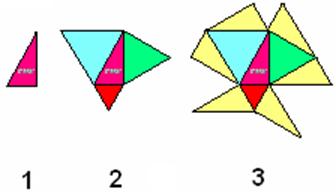 3. The first player places a triangle adjacent to one side of the START triangle. See #2 in the diagram. Play moves to the next player. 4. The players continue to take turns and build a tiling pattern similar to that shown in #3 of the diagram. Note: Two triangles of the same shape and size may not share a common side. 5. A player who cannot add a triangle skips a turn. 6. Play ends when • no player can make an allowable play • one player has used all of his or her triangles 7. The winner is the player with the fewest triangles left at the end of play. |
|
SE page 451 Generate tessellations on the computer | ||
| Shodor Education Foundation, Inc. | ||
| Generate a polygon that repeats without overlapping across a plane. ( http://www.shodor.org/interactivate/activities/Tessellate/ ) |
||
|
SE page 460 Examples of pysankas | ||
| LearnPysanky.com | ||
| Provides examples of pysanka designs. Access enlargements of each design by clicking on the miniatures. ( http://www.learnpysanky.com/designs.html#beg ) |
||
|
SE page 465 Examples of Escher’s art | ||
| M.C. Escher: The Official Web Site | ||
| Click on Picture Gallery and choose Symmetry. Access enlargements of each design by clicking on the miniatures. ( http://www.mcescher.com/ ) |
||
A lot of artists use rotations, reflections, and translations to create beautiful pieces of art. Learn more about tessellations and how to create them as you check out the additional resources on this site. |